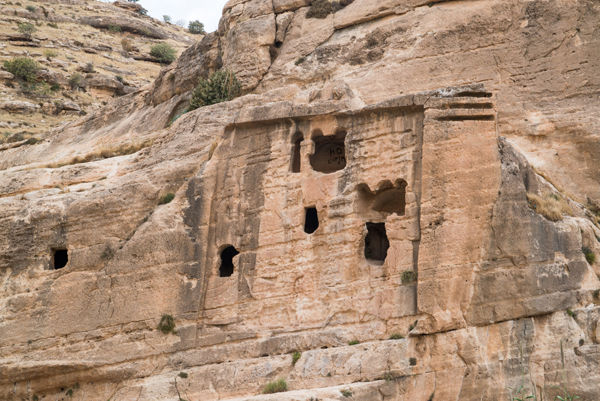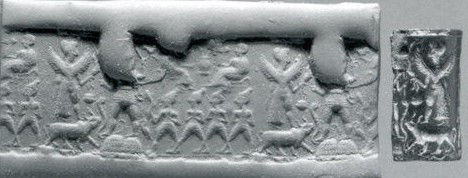Neo-Assyrian Rock Reliefs: Ideology and Landscapes of an Empire
 Helen Malko, Andrew W. Mellon Fellow
Helen Malko, Andrew W. Mellon Fellow
As demonstrated by the exhibition Assyria to Iberia at the Dawn of Classical Age, the early first millennium b.c. was a time of intense cross-cultural exchange, with artistic motifs and styles as well as cultural traits circulating between Assyria, other Near Eastern states, and across the Mediterranean. Cultural influence and innovations are especially visible in Assyrian rock reliefs that were set into the landscape of what is now northern Iraq.
The second of the four rock reliefs at Maltai. ©2013 Mapping Mesopotamian Monuments. Department of Art History and Archaeology, Columbia University. All rights reserved.
Fig. 1. The second of the four rock reliefs at Maltai. Image © 2013 Mapping Mesopotamian Monuments. Department of Art History and Archaeology, Columbia University. All rights reserved.
The most famous Neo-Assyrian rock reliefs are those associated with the northern canal system built by the Assyrian king Sennacherib (r. 704–681 b.c.) to carry water to his capital city of Nineveh and its surroundings. Located in remote mountainous areas, the northernmost and best preserved of these reliefs were sculpted into cliffs on the bank of the river Rubar Dohuk, opposite the town of Maltai (fig. 1), about 70 kilometers north of present-day Mosul, Iraq (see map). The iconography and location of this group of reliefs are of particular interest. Unlike other examples of Assyrian royal art, in which the king is represented worshipping symbols of gods, these reliefs show the king gesturing in front of anthropomorphic deities, or gods in human form. They depict a relatively small figure of the king as a worshipper facing right toward a line of five large gods and two goddesses mounted on animals and fantastic beasts, including from right to left, the gods Ashur, Ninlil, Sin, Anu or Enlil, Shamash, Adad, and Ishtar. Another figure of the king, facing left, is depicted at the end of the row of deities, creating a composition of divine figures flanked by two identical royal images.

Fig 2. The main relief at Khaniss, which portrays Sennacherib worshipping the deities Ashur and Ninlil. Image © 2013 Mapping Mesopotamian Monuments. Department of Art History and Archaeology, Columbia University. All rights reserved.
Although the king is not represented standing on an animal, his similarity to the gods is implied; he, too, carries an attribute in his right hand. Furthermore, the king is also represented within the rings held by the three first deities from right to left: Ashur, Ninlil, and Sin. By integrating the royal figure within a divine attribute, he could have been perceived as if he were a secondary god, an impression reinforced by another image of the king shown supporting the goddess Ninlil’s throne. Although this godlike representation of the king is rarely seen on wall reliefs in Assyrian palaces, including those of Sennacherib himself, it appears to be an innovation especially common on Neo-Assyrian rock reliefs, as evident also at Khaniss (fig. 2), 60 kilometers northeast of Mosul. Another innovation, the display of deities mounted on real or fantastic animals, appears to be a motif borrowed by the Assyrians from Syrian iconography (fig. 3). Indeed, not only the representation of deities on animals but also their appearance in anthropomorphic form can be considered an inspiration derived from Syrian imagery that was common during the second and early first millennium b.c.

Fig. 3. An Old Syrian cylinder seal and modern impression showing a winged goddess on a bull, facing a weather god standing on a snake over two mountains. Cylinder seal, Old Syrian, ca. 1720–1650 b.c. The Metropolitan Museum of Art, New York, Rogers Fund, 1968 (68.57.1)
Although there are no inscriptions associated with the reliefs, their location could provide a clue to their function. The fact that they were placed high over the valley and set into the face of the steeply rising mountain made them difficult to reach, in the past and today. In addition, because of their relatively small size, they are hardly visible from the valley and therefore were not intended to be public monuments. The selection of this inaccessible and nearly invisible natural setting for rock reliefs has to be considered within a religious and spiritual context. The Tigris River was an important symbolic—and actual—source of life and wealth for Assyria. The king, therefore, most likely constructed his reliefs in this location to take advantage of the view down the Tigris, celebrating his hydraulic achievements through monuments that presented him as a protective divine-like king, and declaring his possession of the natural landscape by altering it for many millennia to come. Indeed, even today, Sennacherib’s reliefs at Maltai and Khaniss stand witness to his glory and achievements. However, they are in dire need of conservation and safeguarding against both natural and human elements. The Columbia University project Mapping Mesopotamian Monuments (http://archmap.org/mesopotamia) is one of several ongoing efforts to document and assess Mesopotamian standing monuments, including the Neo-Assyrian rock reliefs at Maltai and Khaniss. This project provides digital records for the monuments and facilitates future conservation work to preserve Mesopotamian cultural heritage as a significant part of our global cultural heritage. Its database of images invites visitors to Assyria to Iberia and the Metropolitan’s superb permanent galleries of Assyrian art (Galleries 400–406) to explore the rich historical landscape of Mesopotamia beyond the walls of the Museum.
http://www.metmuseum.org/exhibitions/listings/2014/assyria-to-iberia/blog/posts/rock-reliefs
